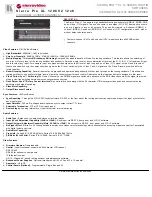
xStack® DGS-3620 Series Managed Switch Web UI Reference Guide
211
PIM-SM
Protocol Independent Multicast - Sparse Mode (PIM-SM) is a multicast routing protocol that can use the underlying
unicast routing information base or a separate multicast-capable routing information base. It builds unidirectional
shared trees rooted at a Rendezvous Point (RP) per group, and optionally creates shortest-path trees per source.
Unlike most multicast routing protocols which flood the network with multicast packets, PIM-SM will forward traffic
to routers who are explicitly a part of the multicast group through the use of a Rendezvous Point (RP). This RP will
take all requests from PIM-SM enabled routers, analyze the information and then returns multicast information it
receives from the source, to requesting routers within its configured network. Through this method, a distribution
tree is created, with the RP as the root. This distribution tree holds all PIM-SM enabled routers within which
information collected from these routers are stored by the RP.
When many routers are a part of a multiple access network, a Designated Router (DR) will be elected. The DR’s
primary function is to send Join/Prune messages to the RP. The router with the highest priority on the LAN will be
selected as the DR. If there is a tie for the highest priority, the router with the higher IP address will be chosen.
The third type of router created in the PIM-SM configuration is the Boot Strap Router (BSR). The goal of the Boot
Strap Router is to collect and relay RP information to PIM-SM enabled routers on the LAN. Although the RP can be
statically set, the BSR mechanism can also determine the RP. Multiple Candidate BSRs (C-BSR) can be set on the
network but only one BSR will be elected to process RP information. If it is not explicitly apparent which C-BSR is
to be the BSR, all C-BSRs will emit Boot Strap Messages (BSM) out on the PIM-SM enabled network to determine
which C-BSR has the higher priority and once determined, will be elected as the BSR. Once determined, the BSR
will collect RP data emanating from candidate RPs on the PIM-SM network, compile it and then send it out on the
land using periodic Boot Strap Messages (BSM). All PIM-SM Routers will get the RP information from the Boot
Strap Mechanism and then store it in their database.
Although Hello packets discover PIM-SM routers, these routers can only join or be “pruned” from a multicast group
through the use of Join/Prune Messages exchanged between the DR and RP. Join/Prune Messages are packets
relayed between routers that effectively state which interfaces are, or are not to be receiving multicast data. These
messages can be configured for their frequency to be sent out on the network and are only valid to routers if a
Hello packet has first been received. A Hello packet will simply state that the router is present and ready to become
a part of the RP’s distribution tree. Once a router has accepted a member of the IGMP group and it is PIM-SM
enabled, the interested router will then send an explicit Join/Prune message to the RP, which will in turn route
multicast data from the source to the interested router, resulting in a unidirectional distribution tree for the group.
Multicast packets are then sent out to all nodes on this tree. Once a prune message has been received for a router
that is a member of the RP’s distribution tree, the router will drop the interface from its distribution tree.
Discovering and Joining the Multicast Group
Two types of distribution trees can exist within the PIM-SM protocol, a Rendezvous-Point Tree (RPT) and a
Shortest Path Tree (SPT). The RP will send out specific multicast data that it receives from the source to all
outgoing interfaces enabled to receive multicast data. Yet, once a router has determined the location of its source,
an SPT can be created, eliminating hops between the source and the destination, such as the RP. This can be
configured by the switch administrator by setting the multicast data rate threshold. Once the threshold has been
passed, the data path will switch to the SPT. Therefore, a closer link can be created between the source and
destination, eliminating hops previously used and shortening the time a multicast packet is sent from the source to
its final destination.
Distribution Trees
Multicast sources do not always join the intended receiver group. The first hop router (DR) can send multicast data
without being the member of a group or having a designated source, which essentially means it has no information
about how to relay this information to the RP distribution tree. This problem is alleviated through Register and
Register-Stop messages. The first multicast packet received by the DR is encapsulated and sent on to the RP,
which in turn removes the encapsulation and sends the packet on down the RP distribution tree. When the route
has been established, a SPT can be created to directly connect routers to the source, or the multicast traffic flow
can begin, traveling from the DR to the RP. When the latter occurs, the same packet may be sent twice, one type
encapsulated, one not. The RP will detect this flaw and then return a Register-stop message to the DR requesting
it to discontinue sending encapsulated packets.
Register and Register-stop Messages
At times on the PIM-SM enabled network, parallel paths are created from source to receiver, meaning some
receivers will receive the same multicast packets twice. To improve this situation, Assert messages are sent from
the receiving device to both multicast sources to determine which single router will send the receiver the necessary
multicast data. The source with the shortest metric (hop count) will be elected as the primary multicast source. This
metric value is included within the Assert message.
Assert Messages
Содержание DGS-3620-28PC-SI
Страница 1: ......
















































